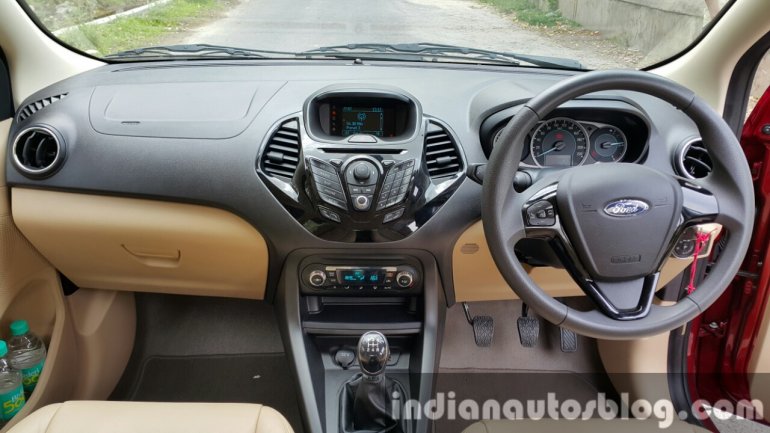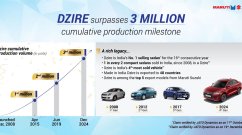Titanium Plus variant comes with six airbags as standard.
Ford will also launch the Ford Figo Aspire with two petrol engines, a 1.2 Ti-VCT and 1.5 Ti-VCT unit, which are paired to a 5-speed manual and 6-speed Powershift dual clutch automatic, respectively. For in-depth details on the exterior, interior and other aspects of the new Figo Aspire, do refer our review of the diesel model.
Exterior Design and Features:
The trim that we tested was the Ford Figo Titanium Plus. The only external difference is that the petrol model gets a "Ti-VCT" badging, unlike the diesel that features a "TDCi" badge.
Interior Design and Features:
The range-topping Titanium Plus trim gets leather upholstery as standard, which improves the premium appeal of the cabin. It is also the first sub-4m sedan to offer leather upholstery from the factory itself. The center console is finished in the same glossy black plastic trim, and it loses the phone docking feature for a SYNC infotainment display with Bluetooth connectivity. It also features more chunky buttons to navigate through the system.
The dedicated infotainment system comes with a voice-command function, which is first-in-class. However it couldn't identify any of the commands in the first try, which is quite a common criticism among most voice command systems in vehicles. Despite being an infotainment system in the range-topping trim, it doesn't feature a full fledged color display with on-board navigation or video support, which is otherwise available in the Honda Amaze and Tata Zest.
In the top-end trim, it gets call functions on the steering wheel, while the tachometer for the petrol model is redlined at 6,500 rpm.
Another feature exclusive to the Titanium trim is the Ford MyKey, which is similar to the parental control feature on a set top box and T.V. When inserted into the ignition, the system identifies the MyKey code, activating the settings pre-selected for the key.
This could prove to be useful when you're handing the car to a valet driver.
Engine Performance:
Powering the Ford Figo Aspire is a new 1.2-liter Ti-VCT petrol engine, which delivers 88 hp at 6,300 rpm and 112 Nm of torque at 4.000 rpm through a standard 5-speed manual gearbox. An automatic 6-speed dual clutch gearbox option is only available in the 112 hp 1.5-liter Ti-VCT petrol variant. We tested the less-powerful Figo Aspire with 1.2-liter engine.
While the noise insulation in the diesel model is something left to be desired, the petrol variant is remarkably silent at idle and the low rev range.
The naturally aspirated engine delivers its power in a very refined and smooth manner, although 88 horses aren't adequate enough to overtake vehicles swiftly. So it seems that while the diesel variant is better suited for the car enthusiast, the petrol variant is for the relaxed driver who just wants to get from A to B smoothly. We reckon that people who mainly commute around the city could find a match in the less powerful and linear petrol engine.
Fuel Efficiency:
The petrol-powered Ford Figo Aspire returns an ARAI-certified fuel consumption figure of 18.16 km/L, which is just 0.16 km/L and 0.56 km/L more than the Honda Amaze 1.2-liter i-VTEC and Tata Zest with the 1.2-liter Revotron engine respectively. However, it's less fuel efficient than the current top dog, the 20.85 km/L Maruti Swift Dzire, as well as the Hyundai Xcent with 19.2 km/L.
Realistically, we managed to secure an average fuel consumption figure of 12.0 km/L, which is nowhere near bad given that the drive involved slow city traffic, fast highway runs with quick deceleration, and heavy cornering.
Ride, Handling, and Braking:
Being a bit lighter than the diesel model has had a small effect in the overall handling of the car. It turns into corners a wee bit better. The suspension is tuned to a slightly firmer setting, so that the car doesn't roll or heave around bends and road modulations. Somehow, the suspension system also manages to grant a relatively smooth ride quality, soaking up small bumps and speed bumps with ease.
The steering feels lighter than the diesel model, which further builds its case as a better city car than a highway cruiser.
Safety:
Given the awareness campaign to improve safety standards of entry-level Indian vehicles, after recent crash test videos opened the eyes of many, Ford is banking on safety features equipped in the Figo Aspire to appeal to prospective customers.
In the Titanium Plus variant that we tested, the Figo Aspire had not one, not two, but six airbags. Apart from the standard driver and front passenger airbags, it also gets curtain airbags on both sides, and side airbags for front occupants. Apart from that, Titanium and Titanium Plus variants come standard with ABS (anti-lock braking system) with EBD (electronic brake-force distribution).
Ford also claims that 45 percent of the body structure has been strengthened with high strength steel, which can only be tested by the boffins at NCAP.
Customers opting for the 1.5-liter Ti-VCT petrol engine with the 6-speed Powershift dual clutch automatic will benefit from the standard ESP, TCS and a Hill Launch Assist, which is a first in the sub-4m segment.
Verdict:
With a smooth power delivery, refined engine characteristics, and lower price, the petrol-powered Figo Aspire is a variant that is worth considering if usage is mostly restricted to the city. However, we would much prefer going for the diesel-powered Figo, mainly due to its drivability and higher fuel efficiency.
That being said, the Figo Aspire petrol will certainly have its fair share of customers, who aren't willing to shell out extra money for the diesel variant, and looking for a composed driving experience.























